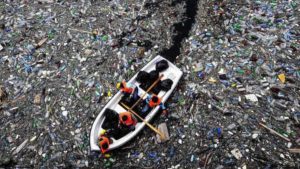One key issue in our society today is our overuse of plastic and disposable water bottles. Last year American consumers used approximately 50 billion water bottles. This contributes significantly to the plastic pollution in landfills and our oceans. In an article published by CNN, the author states that 8 million tons of plastic trash is leaked into the ocean annually, and the problem only continues to get worse. For example, in 1997, Captain Charles Moore, founder of the Algalita Research Foundation, a non-profit group dedicated to solving the issue of marine plastic pollution, discovered a large area of floating plastic in the Pacific ocean. He named the parcel the North Pacific Garbage Patch. The floating island composed of various forms of plastic is located off the coast of Chile and Peru and estimated to total over a million square miles. The North Pacific Garbage Patch is a result of the North Pacific gyre. The gyre has a clockwise circular pattern and is formed by four prevailing ocean currents: the North Pacific current to the north, the California current to the east, the North Equatorial Current to the south, and the Kuroshio current to the west. My proposed solution to this epidemic is the use of simple water purification systems, such as Brita water bottles, jugs, and faucet attachments. Furthermore, instead of repeatedly purchasing water bottles from your local grocery stores, we can purchase reusable water bottles. The amount of money Americans would save is about $4 billion. The key stakeholders in the use of plastic water bottles is the average American household, water bottling organizations, and reusable water bottle manufacturers. My proposed solution has significant social and economic implication and would affect each of these entities both positively and negatively. For the average American, they would save a significant amount of money but loose a portion of their quality of life. Disposable water bottles are extremely convenient, causing individuals to prefer them over refilling a reusable water canteen. For water bottling companies, they would lose a large portion of their market share if a majority of Americans switched to reusable water decanters. This would result in a remarkable decrease in sales revenue for these enterprises. However, this would provide them the opportunity to diversify their product offerings. These companies could infiltrate the reusable water bottle market, giving them the opportunity to make up for their deficit in both market share and sales revenues. For reusable water bottle manufacturers, my solution would increase their sales revenue and potentially their market share. Contrarily, if disposable water bottling companies decided to start producing reusable ones the existing non-disposable manufacturers would lose a portion of their market share and profit. I believe that my solution is extremely viable. In order for this change to occur civilians would need to be further educated on the environmental impacts of plastic use. Furthermore, Americans would need to be convinced that reusable water bottles are no less convenient than disposable ones. I believe that if we all made this change we would impact the environment positively and, in turn, reduce our economic footprint significantly.
Citations:
https://en.wikipedia.org/wiki/North_Pacific_Gyre
https://www.nationalgeographic.org/encyclopedia/great-pacific-garbage-patch/
http://www.cnn.com/interactive/2016/12/world/midway-plastic-island/
https://news.nationalgeographic.com/2017/07/ocean-plastic-patch-south-pacific-spd/
https://www.banthebottle.net/bottled-water-facts/

